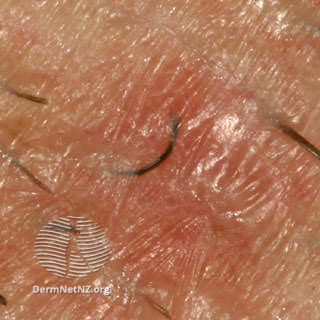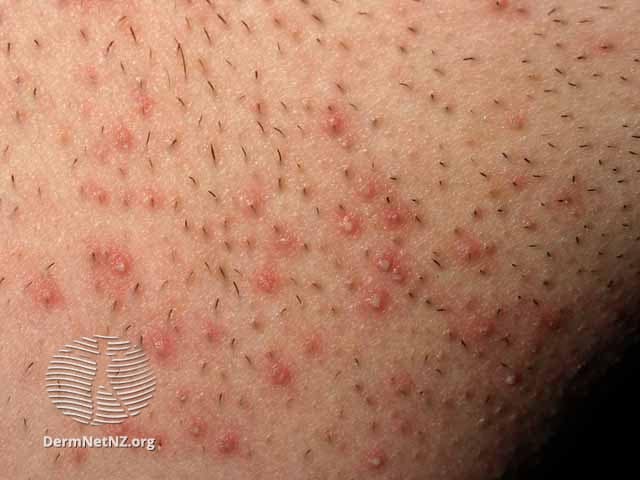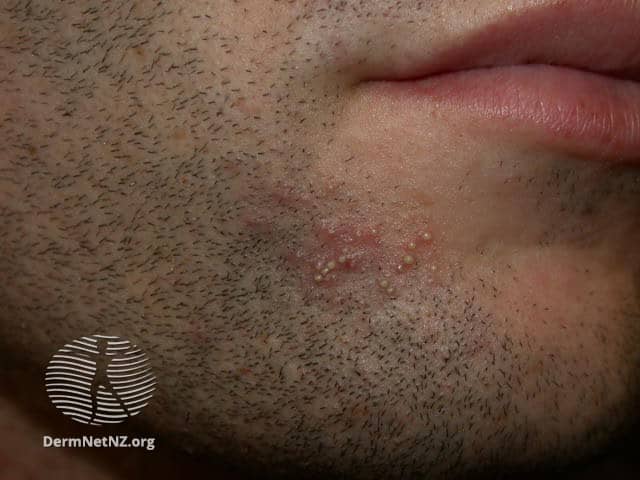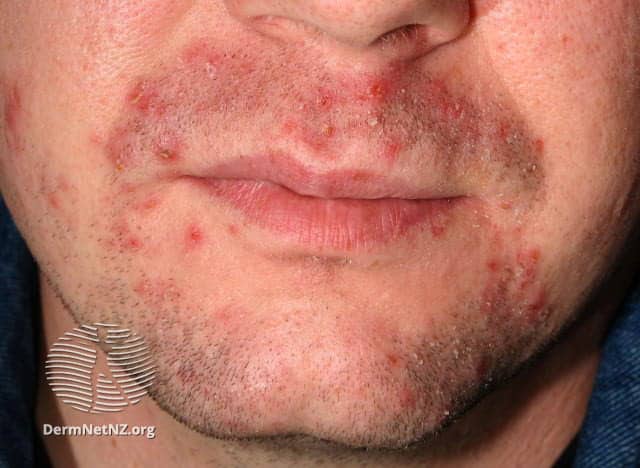Shavers all over the world are united with these common problems.
- Ingrown Hair
- Razor Burn
- Folliculitis Barbae
- Cuts
There are solutions for us though so let us look into them in more detail and improve our shaving experience.
Ingrown hair
Ingrown hairs are one of the most common shaving related problems. They are caused when the hair is cut too short and the hair grows back at an angle into the skin. The hair then becomes trapped under the skin and continues to grow. The area with the ingrown hair will become red and itchy, a bump may appear similar to a pimple. sometimes you can see the hair growing just under the skin. Ingrown hairs are known medically as Pseudofolliculitis Barbae. This should not be confused with Folliculitis Barbae.

Solution
- Always shave with the direction of your hair growth.
- Don’t stretch the skin while shaving.
- Use a Safety Razor rather than a multi-blade cartridge.
- Use a Shaving Brush to apply lather, this will also lift the hairs.
- Change your blade regularly.
- Rinse the razor frequently to remove hair and soap.
- Apply Witch Hazel as an aftershave
Remedy
If you already have ingrown hairs, try these tips to help clear them faster.
- Gently exfoliate the area to try and lift the hair. An exfoliating glove used in the shower or gentle brushing with a dry toothbrush can help the ingrown hair to break through and grow normally.
- Make a paste with crushed Aspirin and water then apply it to the affected area then rinse after a few minutes. The paste will gently exfoliate the area and since Asprin is also anti-inflammatory, it can help reduce swelling and redness.

Razor Burn
Have you ever had an itchy burning sensation after you shaved? Your skin may look red and irritated. That sensation commonly known as Razor Burn. The problem with razor burn is that it usually doesn’t appear until after the shave is finished and by that point, it’s too late to change anything with the shave routine to combat it.
The common causes of razor burn tend to be:
- Poor preparation of the skin prior to shaving and lack of hydration during the shave.
- The razor you use is blunt.
- Using multi-blade cartridges.
- Applying pressure onto the razor while shaving.
- Skin reaction to the lather product you are using.
Solution
Using a good shaving soap and applying lather with a brush will ensure the skin is prepared and hydrated during the shave.
Regularly replacing the blade is a good way to eliminate a lot of shaving problems and razor burn is often caused by a blunt blade. I generally change the blade after 3 shaves but if I feel it starting to tug the hairs before the 3rd shave then I switch it out then. They are so cheap to buy that it isn’t worth taking a chance of having post-shave issues.
Multi-blade cartridges for me were a major cause of razor burn and irritation. Lots of my shaving problems disappeared when I changed to a Safety Razor and Double Edge blade.
Applying (downward) pressure on the razor is a big factor in irritation and razor burn. This also touches on the previous point of multi-blade cartridges, sorry to harp on about them but the pivot head design lends itself to needing downward pressure to get a decent shave. Removing the pressure and letting the weight of the razor take care of the shave will stop razor burn in its tracks… assuming you are using a Safety Razor. Can you see a pattern forming yet?
Last but not least is the possibility that something in your shaving soap, cream or aftershave is reacting with your skin. If everything else seems ok but you are still experiencing irritation then try removing products one by one until you find the culprit.
Remedy
There isn’t really a remedy for razor burn it’s more a case of lessening the effects. It really is a case of prevention is better than the cure so follow the suggestions in the solution section but, there are a few things that will ease the discomfort.
- Thoroughly rinse with clean water after shaving.
- Try Witch Hazel as an aftershave, it can reduce the effects for some people.
- Try Aloe Gel as an alternative to Witch Hazel.
- Keeping the affected area moisturised will to help ease the discomfort. There are lots of after shaving balms available.
Folliculitis Barbae
Folliculitis Barbae, try saying that three times fast, is the medical term for infection of the hair follicle in the beard area. Hair grows from tiny structures in the skin called follicles. When the follicle becomes inflamed the term folliculitis is used. Barbae originates from the Latin word for ‘beard’ (barba). The symptoms are small, itchy, raised pustules.

Remedy
If you experience symptoms of Folliculitis Barbae then it is wise to seek medical advice. However, the infection is spread by contaminated shaving equipment so if we stick to our guidelines of changing blades regularly and also cleaning our razor regularly we should be able to minimise the chance of cross-contamination.
Nicks and Cuts
It’s inevitable, we will cut ourself shaving once in a while. This is especially true when we make the switch from cartridge razors to safety razors. The good news is that it happens less and less as we relearn the skill of shaving and if we implement a routine based on what we discussed earlier. Even so, it will happen now and then. Fortunately, we have some great little pieces of kit in our wash bags to fight back.
Setting aside technique as a cause of cuts, one should be on the lookout for these potential causes.
- Blunt blade
- Poor lubrication from lather
Solution
The first solution is easy, change the blade. A blunt blade is going to cause us no end of problems and should be the first thing we look at when eliminating possibilities.
Lather problems can be tricky to iron out but it’s easy enough to spend a little bit of time practising our lathering technique. Follow out lathering tutorial and have a go at making test lather. You can experiment with the amount of water you use in order to dial in what feels best for you. It’s also worth making up test batched with too much and too little water so you can feel the difference in the foam.
Remedy
A styptic pencil should be one of your first purchases, very cheap and great to stop bleeding from small cuts. Simply wet and rub it on the affected area to seal, it will sting a little though so be warned.
Similar to a styptic pencil, an Alum Block will also help seal small cuts and nicks. It has the added advantage of being large enough to use as an aftershave astringent for the whole face. Wet and apply but some people like to rinse afterwards if using as an aftershave.
Last but not least we have Proraso Cut Healing Gel, slightly more expensive but less messy than a styptic pencil or Alum Block.

